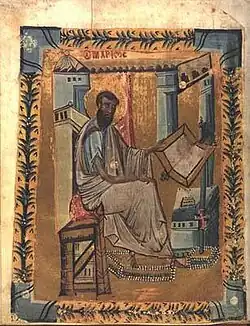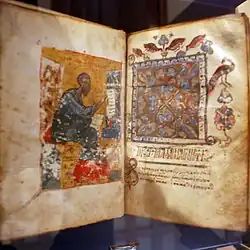Trebizond Gospel
| New Testament manuscript | |
 Illumination representing Mark the Evangelist | |
| Text | Gospels |
|---|---|
| Date | 11th century |
| Script | Greek |
| Now at | Russian National Library |
| Size | 33 by 36.5 cm |
Trebizond Gospel, ℓ 243 (in the Gregory-Aland numbering), is a Byzantine illuminated manuscript with the text of Gospel Lectionary, dating palaeographically to the 11th century, with 15 parchment leaves (33 by 36.5 cm) from the 10th century or earlier.[1]
The manuscript is thought to have been created in Constantinople, probably commissioned by a Byzantine Emperor. [2] The book was later decorated with gold and jewels by Andronicus II of Trebizond (reigned 1263 – 1266). In 1858, the manuscript was presented by the Orthodox Metropolitan of Trebizond as a gift to Alexander II of Russia, who in turn donated it to the Imperial Russian National Library. It is still held in that library.[3]
Description

The text is written in two columns per page, 18 lines per page in uncial letters.[3] It contains 15 pictures.[4] It is not known where it was created due to its colophon being lost.[2] Originally it was believed to have originated from the eastern provinces of the Byzantine Empire but later Russian analysis placed it as being from Constantinople due to the art style.[1] It combined Greek illustrations with Armenian pigments. It is believed to have been a commission from the Byzantine Emperor due to the level of detail within it.[2] The Canon tables within it are made distinct from each other, with elaborate designs of flowers and peacocks across the pages of the Gospel.[5] Though the Gospel still portrays the Four Evangelists as being together in a single folio to demostrate the harmony of the four Gospel accounts.[6]
The book was richly decorated with gold and jewels by the Trapezuntine Emperor Andronicus. In 1858, the Trebizond Gospel was presented by the Orthodox Metropolitan of Trebizond to the Emperor Alexander II of Russia, who donated it to the Imperial Russian National Library, where is held to the present day (Codex Gr. 21, 21a).[3]
It was examined and described by Eduard de Muralt.[7] The manuscript is not cited in the critical editions of the Greek New Testament (UBS3), because of its small textual value.[8]
See also
References
- ^ a b "Ostromir Gospel and the Manuscript Tradition of the New Testament Texts: Gospel of Trebizond". National Library of Russia. Retrieved 14 July 2025.
- ^ a b c The Glory of Byzantium: Art and Culture of the Middle Byzantine Era, A.D. 843-1261. Metropolitan Museum of Art. 1997. p. 358. ISBN 9780870997778.
- ^ a b c K. Aland, M. Welte, B. Köster, K. Junack, Kurzgefasste Liste der griechischen Handschriften des Neues Testaments, (Berlin, New York: Walter de Gruyter, 1994), p. 243.
- ^ C. R. Gregory, "Textkritik des Neuen Testaments", Leipzig 1900, vol. 1, p. 408.
- ^ Bedrosian, Margaret (1991). The Magical Pine Ring. Wayne State University Press. p. 15. ISBN 9780814323397.
- ^ "The Art of the Book" (PDF). Fresno State University. p. 94. Retrieved 14 July 2025.
- ^ Eduard de Muralt, Catalogue des manuscrits grecs de la Bibliothèque Impériale publique (Petersburg 1864), pp. 40-41.
- ^ The Greek New Testament, ed. K. Aland, A. Black, C. M. Martini, B. M. Metzger, and A. Wikgren, in cooperation with INTF, United Bible Societies, 3rd edition, (Stuttgart 1983), pp. XXVIII, XXX.
Further reading
- Eduard de Muralt, Catalogue des manuscrits grecs de la Bibliothèque Impériale publique (Petersburg 1864), pp. 40–41.
- Likhachova V. D., Byzantine miniature, Moscow: Iskusstvo Art Publishers 1977, p. 14.
External links
- Digitized copy at the Walters Art Museum
- Russian National Library
- Trebizond Gospel at the Russian National Library